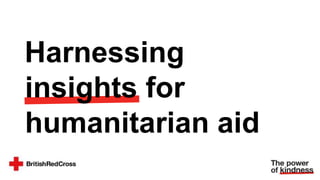Harnessing insights for humanitarian aid
- 2. Everyone gets the help they need in a crisis
- 3. Disasters & Emergencies People are safe and able to survive and recover whenever disaster strikes - Emergency response - Community education - Resilience-building
- 4. Health inequalities People in the UK receive the care and support they need without falling through gaps in the health system - Assisted discharge - ŌĆ£High-intensityŌĆØ use of unplanned care - Signposting - Digital inclusion - ŌĆ£Waiting wellŌĆØ
- 5. Displacement & Migration People experiencing displacement feel safe, live with dignity and have choice and opportunity on their journey - Find missing loved ones - Help leaving unsafe situations - Help accessing support - Cash assistance - Psychosocial support
- 6. A team of researchers and analysts using qualitative and quantitative methods to produce actionable insights about the systems and contexts in which we work, as well as monitoring emerging needs and anticipating future crises. Who are we? > Resilience Index > Data science > Horizon scanning > Scenario planning > SWOT and PESTLE analysis > Early action briefings > Thematic insight packs > Designing research > Reviews and summaries of evidence What do we do?
- 7. Pandemic
- 8. Mapping vulnerability to Covid-19 A UK-wide, neighbourhood-level composite index: - Clinical vulnerability - Socioeconomic vulnerability - Wider health and wellbeing Also used by: - Scottish Public Health Observatory - Local Authorities - Community Foundations - Arts Council England - ŌĆ” and others
- 9. Targeting our Hardship Fund Short-term financial support for certain at-risk groups: > People with No Recourse to Public Funds > People aged 70 or older > People who have had disruption or delay to statutory support > Household who have lost their primary earner to coronavirus > Survivors of gender-based violence, including domestic abuse > People facing homelessness or living in temporary accommodation ┬Ż5m to 13,000 people Combining data analysis with local intelligence East Anglia ’āĀ coastal and seasonal needs, loss of income Midlands ’āĀ refugees at risk of destitution ~12% of eligible people
- 10. Leaflet drops for digitally excluded older people in Essex
- 11. Supporting flu vaccines in Trafford and identifying sites for mobile Covid-19 testing
- 12. Shetland Islands Mapping Covid-19 vaccine hesitancy Targeting places with low vaccination coverage ŌĆó Likely vaccine hesitancy (unwillingness) in Local Authorities ŌĆó Vaccine hesitancy was modelled using five indicators, found consistently across studies: Gender Ethnicity Income Education Flu vaccination
- 13. Anticipating Omicron (and other emerging variants)
- 14. Storms & floods
- 15. Vulnerability profiles for emergencies
- 16. Changes to population age and health were the biggest drivers behind change in vulnerability to flooding North East and North West had the highest proportion of neighbourhoods becoming more vulnerable.
- 17. Ukraine
- 20. WhatŌĆÖs next?
- 21. Cohorts analyses for our three causes Emergency planning tool Capacity planning (with Pro Bono OR volunteer) Resilience Index > Disasters & emergencies > Health inequalities Scenario planning / horizon scanning > Ukraine > Strategy for 2023-25 Embed insight products in decision-support tools
- 22. Strategic Insight & Foresight team > Elle Gordon > Freya Neason > Mike Page None of this would have been possible withoutŌĆ” Experts volunteering their time and brainpower > Stefan Noble (Oxford Consultants for Social Inclusion) > Obi Thompson Sargoni (Centre for Advanced Spatial Analysis, UCL) > Brian Johnston (Queens University Belfast) > Elise Paul (University College London) > Tom Russell (University of Oxford) Say hello: MattThomas@redcross.org.uk @matthewgthomas > Clare Darlow > Aileen McDonald > Gena Burgess
Editor's Notes
- #4: Response include practical and emotional support; cash assistance
- #7: Targeting resources ŌĆō ŌĆ£high risk low resourceŌĆØ Where weŌĆÖd have most meaningful impact
- #9: Similar approach to IMD Arts Council England used VI to determine funding awards to priority places in the South West Also cited by OR Society in your Covid-19 Resource Hub
- #10: ŌĆ£The work Central did with the VI and Hardship Fund has resulted in 51% of our Hardship Fund referrals being in the top three deciles for vulnerability. Making sure that the people who needed it the most have received it.ŌĆØ ŌĆō Lee Revis Reached around 1 in 8 or 1 in 9 people eligible for support
- #13: Hesitancy: Women People from BAME backgrounds ŌĆō although not every study found this People on lower incomes And with lower educational attainment People who didnŌĆÖt get a flu jab in 2019 Older people are more worried about unseen side effects Some people believe natural immunity offers better protection Nearly half of those who are currently unwilling to take the vaccine want to wait until it has been used more widely to determine its safety Some studies found greater vaccine hesitancy among people from BAME backgrounds, though other studies have not
- #14: Helped inform decision-making around VCS involvement in the Christmas vaccine drive
- #16: Revealed gap between strategic intent (to target resources, to be anticipatory) and operational reality, particularly during emergencies
- #17: Informing recruitment of people with lived experience of flooding to a large-scale research project























